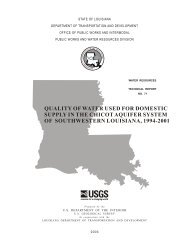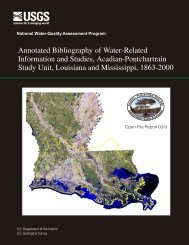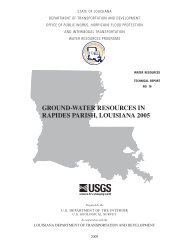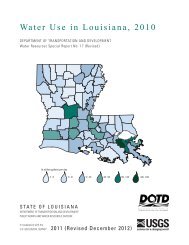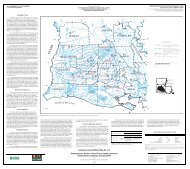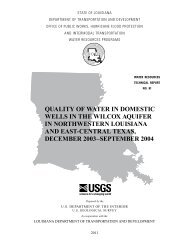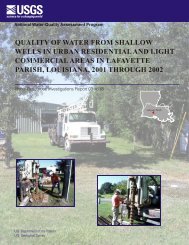environmental setting, water quality, and ecological indicators of
environmental setting, water quality, and ecological indicators of
environmental setting, water quality, and ecological indicators of
Create successful ePaper yourself
Turn your PDF publications into a flip-book with our unique Google optimized e-Paper software.
invertebrate species in relation to <strong>environmental</strong> variables.<br />
Communities at large-basin sites tended to vary<br />
along the dissolved-oxygen <strong>and</strong> open-canopy gradient,<br />
whereas communities at small-basin sites tended to vary<br />
along the instream-cover <strong>and</strong> fipronil-concentration gradient.<br />
Water-Quality Characteristics<br />
Significant statistical differences (p ≤ 0.05) in<br />
<strong>water</strong>-<strong>quality</strong> characteristics occurred among CCA site<br />
groups (table 11). Median values were smallest for 17<br />
<strong>water</strong>-<strong>quality</strong> variables at group A sites <strong>and</strong> largest for<br />
11 <strong>water</strong>-<strong>quality</strong> variables at group B sites. Median values<br />
<strong>of</strong> turbidity, <strong>and</strong> concentrations <strong>of</strong> total ammonia<br />
37<br />
plus organic nitrogen, nitrate, total phosphorus, <strong>and</strong> dissolved<br />
fipronil, were largest at group C sites. Group D<br />
sites were characterized by midrange concentrations for<br />
all <strong>water</strong>-<strong>quality</strong> variables except concentrations <strong>of</strong> dissolved<br />
oxygen, which were lowest.<br />
Possible explanations for the differences in <strong>water</strong><br />
<strong>quality</strong> among site groups include the differences in (1)<br />
general soil composition <strong>and</strong> drainage characteristics<br />
(Touchet <strong>and</strong> others, 1974), <strong>and</strong> (2) the percentage <strong>of</strong><br />
l<strong>and</strong> used for agriculture in these basins. Drainage areas<br />
for sites in group A are low in agricultural intensity <strong>and</strong><br />
contain pine upl<strong>and</strong>s <strong>and</strong> alluvial terraces. Soils are<br />
acidic <strong>and</strong> loamy with moderate s<strong>and</strong> content <strong>and</strong> are<br />
moderately well-drained. Drainage areas for group B<br />
Table 11. Median <strong>water</strong>-<strong>quality</strong> variables for canonical correspondence analysis (CCA) site groups in<br />
southwestern Louisiana, 2001<br />
[Boldface values indicate significant differences (p ≤ 0.05) among site groups, based on Kruskal-Wallis test; for each variable, values preceded by<br />
the same superscript letter are not significantly different from each other. n, number <strong>of</strong> sites; mg/L, milligrams per liter; µS/cm, microsiemens per<br />
centimeter at 25 degrees Celsius; NTU, nephelometric turbidity units;



